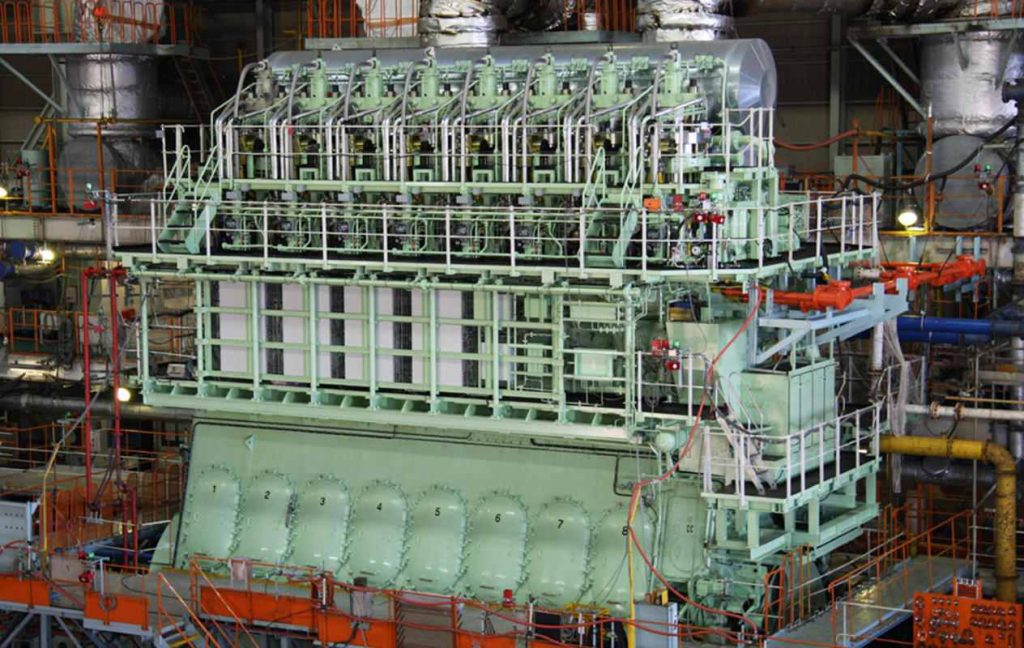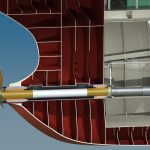Marine diesel engines and engine rooms have changed a bit since I was a young engineer at sea in the 1960’s. Nowadays modern engines are designed to be more economical and emit fewer toxic exhaust gas fumes.
Ships main engines are a major cause of air pollution, and because of this, legislation has been introduced to reduce ships exhaust gas emissions. Ship owners demanded improvements, and ship designers reacted by developing modern efficient ships engines and engine rooms.
The following sections examine these modifications beginning with a description of the methods employed in reducing the emissions.
Reduction of Sulfur from Fuel Oil and Exhaust Gasses
The two main pollutants are sulfur oxides (SOx) and nitrogen oxides (NOx), and several methods are being used reduce these emissions.
Reduction of Sulfur Content in Heavy Fuel Oil (HFO)
Heavy fuel oil is a by-product of the process of the refining of crude oil
and is supplied to the industry from the residue of the distilling columns, known as “bottoms.” This is in fact the bottom of the barrel and contains a few nasty contaminants, among which is sulfur.
So, this HFO can be reformulated to reduce the sulfur content before we load it as ships bunkers- but at a cost.
This increase in price, along with the general rise in fuel prices, is too much for some of the shipping companies. However there is another method of removing the sulfur, by post combustion treatment through scrubbing the exhaust gas fumes explained below.
Use of Scrubbers to Reduce Sulfur Oxides from Exhaust Gasses
Scrubbing the exhaust gasses does not come cheap either, but once the plant is installed the ship’s engines can be run on the normal, cheaper HFO.
The scrubber is a vertical pressure vessel that is normally located in the funnel as there is usually space to fit it there, as well as being convenient to the exhaust piping to the silencer before exit to atmosphere.
There are several types of gas water scrubbers suitable for use in ships.
○ Seawater Washed
○ Fresh Water Washed
Both systems use the same principle of spraying water onto the outgoing exhaust gas streams as they pass up through the scrubber perforated plates, with the resulting gasses being up to 99% sulfur free, regardless of the sulfur content in the fuel being combusted.
○ Seawater Scrubber
The seawater scrubber works on the principle that seawater is alkaline from containing insoluble calcium salts. It is these salts that react with the sulfur dioxide in the exhaust gasses, neutralizing them before falling down into a storage tank. Modern plants supply more seawater to this solution, with the added alkali further reducing the SOx levels in the water contained in the tank.
There is an added bonus when scrubbing to remove SOx as the particulates in the gas are also removed. These are collected by seawater spray, before these too fall into the storage tank.
An efficient wash-water plant removes most of the solids before returning the solution to the sea; the remaining solids are pumped ashore for disposal while in port.
○ Freshwater Scrubber
The freshwater scrubber works in a similar manner, only this time sodium hydroxide (NaOH) is added to the freshwater in a mixing/holding tank. The resultant solution is then sprayed into the exhaust gasses as they pass up through the scrubber, once again neutralizing the SOx in the gasses.
The resultant solution is then subjected to water wash treatment, with the clean water being pumped overboard with the effluent/solids mix going to a sludge tank for disposal ashore.
A typical fresh water gas scrubber is shown below. (Please click on the image to enlarge.)

Reduction of Nitrogen Oxides (NOX’s) from the Exhaust Gasses
Nitrogen oxides are a product of the combustion of HFO in air, and between 5% and 8% of these are removed by the scrubbers. One way to reduce this further is to raise the thermal efficiency of the engine by using common rail fuel injection and running the engine at a more economical speed, reducing the fuel consumption.
However, the latest method of reducing NOx in the exhaust gasses is to inject CO2 into the combustion air inlet system, thus lowering the temperature of combustion. High temperature combustion is the cause of the NOx’s.
Engine Room Efficiency Improvement Components
○ Exhaust Gas Waste Heat Boilers
Exhaust gas waste heat boilers are nothing new; we had them in the engine rooms in the 1960’s. What is new though is that modern exhaust gas boilers have been designed to produce superheated steam as well as saturated steam. The saturated steam is used for accommodation utilities and numerous engine room heaters.
○ Steam Turbine Generator
The superheated steam is piped to a steam turbine coupled to a power generator that can have an output up to 8MW.
Because of the more efficient main engine, about 10% of the exhaust gasses can be diverted before the turbo blowers. These gasses are redirected to an exhaust gas turbine connected to the steam turbine drive shaft. A clutch allows the exhaust turbine to be connected or disconnected from the main drive as required.
The condensed steam from the turbine is reheated by being passed through the jacket water and lube-oil coolers before returning to the boiler.
○ Electric Drive
The last innovation of the efficient engine room is the coupling of one or two electric motors to the main engine prop shaft. These can be supplied by the steam turbo generator or one of the auxiliary diesel generators.
My depiction of a typically efficient and environmentally friendly engine room is shown below..

MAN/B&W and Sulzer/Wartsila, the remaining major engine manufacturers, have spent a lot of time in research and development of these engines and their engine rooms. Having sailed as engineer on ships powered by both of these large two stroke, low revving beasts, it is good to see them still about in the market.
So there we have it – the modern efficient engine and engine room- a far cry from when I was at sea. Although I reckon I could still stand a watch or two in these engine rooms. Now where did I put that Merchant Navy Officers Discharge Book? I definitely had one in 1973!



Comments are closed